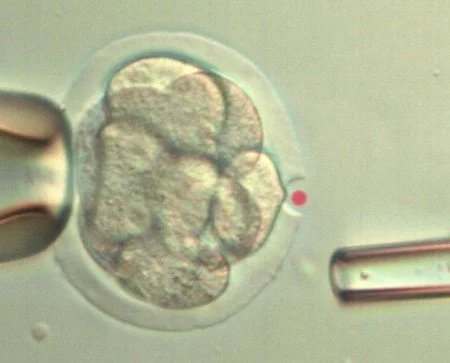Is Assisted Hatching Safe? Evidence-Based Risks vs. IVF Success Benefits
Assisted hatching (AH) is a laboratory technique used during in vitro fertilization (IVF) to help embryos implant into the uterine lining. It involves creating a small opening in the embryo's outer shell, the zona pellucida, using methods such as lasers, chemicals, or mechanical tools. This procedure is typically considered for all patients, but its benefits and risks vary depending on individual circumstances.
Reference - Hamilton Thorne
The Current State of Assisted Hatching Technology
Modern assisted hatching primarily utilizes computerized infrared laser systems (1480nm wavelength), creating precise 20-40μm openings in the zona pellucida. These advanced systems represent a significant improvement over earlier mechanical or chemical methods, offering:
Sub-millisecond pulse durations (typically 5-15ms)
0.1μm precision in opening size
Real-time thermal sensors ensuring adjacent embryo areas remain within 0.5°C of baseline
Automated targeting that avoids cellular structures
Safety Profile: What the Research Shows
Embryo Safety Data
When AH is performed, especially using lasers, specific safety protocols are followed to minimize risks:
Controlled laser parameters: Lasers used for AH are calibrated to deliver precise energy levels, ensuring that the embryo is not exposed to excessive heat or damage.
Experienced embryologists: The procedure should be carried out by trained professionals who can accurately perform the technique and monitor the embryo's condition throughout the process.
Now don’t look at this and think it’s completely safe! It “can” be completely safe depending on the SKILL of your embryologists. We are talking about a HIGH-POWERED laser that reaches extreme temperatures to vaporize material (aka your zona pellucida shell). If the laser is in the wrong hands, then it can certainly be damaing, but rest assured that reputable labs know how to handle this!
Clinical Risks
Monozygotic twinning: Increases from 1.1% to 1.8% (RR 1.6)
Embryo loss: Additional 1.2% risk post-hatching
Implantation failure: No increased risk when properly performed
Efficacy: Who Actually Benefits?
Proven Beneficiaries
Patients with poor prognosis
Meta-analysis of randomized controlled trials found AH significantly increased pregnancy, implantation, and ongoing pregnancy rates in patients with poor prognosis!
Women ≥38 years
11.3% increased implantation rate (95% CI 5.2-17.4)
Likely due to age-related zona hardening
Previous IVF failures
8.7% higher LBR after ≥2 failed transfers
Especially valuable when good-quality embryos failed to implant
Thick zona pellucida (>15μm)
14.2% improvement in clinical pregnancy
Measured via polarization microscopy
Check out this patient’s successful pregnancy outcome using laser-assisted hatching and platelet-rich plasma (PPR) perfusion!
Limited/No Benefit Groups
Donor egg recipients (0.9% difference)
PGT-A normal embryos (no significant improvement)
It should be noted that PGT-A requires some form of assisted hatching because the embryologist must open the zona pellucida to collect biopsy samples! Now this could mean that assisted hatching won’t be necessary during the transfer phase because a small hole was already created during the biopsy step!
First-cycle IVF patients with good prognosis
Technical Factors Impacting Outcomes
Optimal Timing
Day 3 hatching: Better for slow-developing embryos
Day 5 hatching: Preferred for blastocysts with a thick zona
Opening Size Matters
<30μm: Risk of inadequate hatching
>50μm: Increased embryo damage risk
40μm: Ideal balance in most cases
Professional Guidelines Consensus
ASRM - Reasonable for selected patients (2023)
ESHRE - Not routine, consider for RIF/thick zona (2022)
FDA - Class II medical device clearance (2021)
What Should You Do?
Assisted hatching is one of those small but powerful tools in the IVF journey. When done properly and for the right reasons, it carries minimal risk and can offer real, measurable benefits—especially for certain groups of patients. The cost typically ranges from $200 to $600, depending on the clinic, but in the context of the full IVF process, it's a relatively small investment that might make a big difference.
Multiple studies have shown that assisted hatching can improve implantation rates, and while its effectiveness can vary based on individual circumstances, it’s a step worth considering for nearly everyone. In a process as emotionally and financially demanding as IVF, every detail matters—and this is one detail that might give your embryos that extra nudge they need.
At The IVF Kitchen, we genuinely believe in assisted hatching. We recommend it for all our patients, regardless of their prognosis, because in this delicate and deeply personal process, every single percentage point of increased success is meaningful. That said, we also know there's no magic bullet in fertility treatment. It’s important to stay grounded and realistic about what assisted hatching can do—but hopeful, too.
Because sometimes, it’s the smallest things that help dreams grow.
“If you can’t handle the heat, then get out of the IVF Kitchen!”

